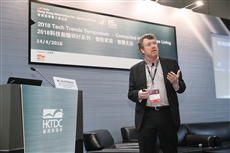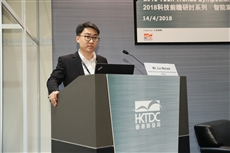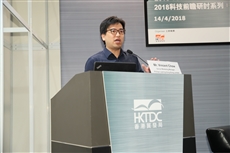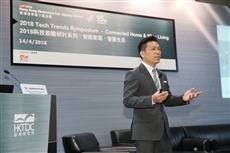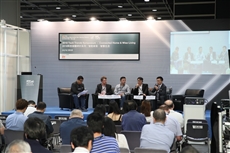Connected Home, Smart Living
17 April 2018 – The 15th edition of the Hong Kong Electronics Fair (Spring Edition), Asia’s largest event of its kind, was held from 13- 16 April at the Hong Kong Convention and Exhibition Centre (HKCEC). A series of seminars was organised during the first three days of the fair, as part of the “2018 Tech Trends Symposium”, including one focusing on smart homes, held on 14 April.
Building the foundation for a revolutionary Smart Home
The evolution of the Smart Home is among the many Internet of Things (IoT) revolutions, according to David Paterson, Sales Director, Connected Home Division, Intel Corporation, one of the Symposium speakers.
But despite its advent five to six years ago, Mr Paterson said the IoT revolution has yet to fully be realised. The foundation for a true Smart Home, he said, remains under construction, with its progress divided into four phases. The most developed stage, connectivity, allows mobile devices to connect with machines such as appliances and lighting through WiFi connections. The second phase is control, which involves using the smartphone, for example, as a smart controller. The third phase is communication, allowing devices to talk to each other by using a single controller for various applications, such as lighting, appliances and entertainment. The main focus of the speaker’s presentation was the final phase – intelligence – which he said is now under development.
Mr Paterson explained that a truly smart home is (1) responsive, in terms of doing what users want, immediately and accurately; (2) perceptive, by recognising who is giving the command and what the user wants, and (3) autonomous, which allows it to anticipate user needs and act on them.
On the subject of industry needs, Mr Paterson said top among them is performance. The broadband network, he said, must be reliable and respond instantaneously. Second, the network must cover the entire home. Third, it must guarantee secure transmission and protection of data, which remains a problem, given the huge amount of data sent to equipment-providers and stored on the cloud. He said that the issue was a major development focus for Intel.
He pointed out that the number of connected devices was expected to double in two years, and that growth will require powerful, affordable broadband access, enhanced in-home connectivity and artificial intelligence (AI) in devices at all levels, to filter the huge amount of data generated daily.
Artificial Intelligence Used in Different Areas
Speaking on the topic of AI development, Liu Weiwei, Sales Director of Smart Service Division, iFlytek, focused on iFlytek’s success in the areas of speech synthesis and translation. Noting the three levels in AI development – computation intelligence, perceptive intelligence, which involves hearing, speaking and seeing; and cognitive intelligence, which involves understanding – Mr Liu said that iFlytek’s translation corpus is based on 140 million sentences and can accurately translate within one second. For now, however, the company still has to rely on human translators to work with machines for higher accuracy. Jargon, in particular, remains a problem in speech recognition.
China’s massive outbound tourism has resulted in fast-growing demand for iFlytek’s translation service. In 2016, 122 million mainland tourists travelled abroad, one third of whom can only speak their native language. The iFlytek translation system can translate more than 20 languages. Chinese travellers can also use the company’s offline mode when there is no Internet available.
In addition, Mr Liu said that iFlytek’s smart doctor assistant was the first AI robot to pass the examination medical students take to become licensed doctors in China, noting that the system works considerably faster than human doctors. He said that this could have a lasting impact on the medical field in terms of reducing costs, improving patient outcomes, and helping people in rural areas.
In the legal field, the company helps stenographers achieve 97 per cent accuracy. Its robots are currently handling customer-service jobs in insurance companies and banks, and Mr Liu predicted that human bank clerks will eventually be replaced by robots.
Helping Businesses Participate in the Smart Home Revolution
Alex Yang, co-founder and COO, Tuya Global Inc, discussed ways businesses can be part of the Smart Home revolution, pointing out that in five years, the smart home industry is expected to become a US$1 trillion market, with 5.28 billion devices estimated to be added annually by 2020. He said Amazon Echo and Google Home had reached 40 million US consumers in only two years, representing more than 10 per cent of the population, compared to the smartphone revolution, which took four to five years to achieve the same level of adoption. “Interest is high,” he said. “But how can we connect with this new business?”
Mr Yang said that business must first make adoption easy. To achieve this, Tuya created a plug-and-play platform to help manufacturers with no know-how, to develop and market smart home products. A company, he said, can develop a mobile app in one hour and a prototype in one day, and be ready for mass-production in one month. The Tuya platform covers all smart-home categories, including appliances, healthcare, security, entertainment. Tuya develops clients’ product and finds a manufacturer for them through its network of more than 10,000 manufacturers in China that works with many OEM and ODM brands. Once the supply chain is ready, the Tuya platform connects with all the best-selling points and is immediately compatible with all devices and products in all languages.
AI and big data-enabled, the platform has natural language interaction, uses sensor data for intelligent control, permits continuous self-learning of user habits, and has face and object recognition.
Tuya is currently expanding globally, with a target for its cloud service to cover 200 countries and regions in the next two years.
How Smart Home Products can Provide Wise Living
Vincent Chow, Senior Marketing Manager, Philips Lighting Hong Kong Ltd, discussed the limited functionality of most smart home products. Being able to remotely switch off home lights via smartphones is not as popular in Hong Kong.
He remarked that the goal of his team at Philip’s was to use interconnected devices to encourage smart living. Initially, his team found that the only consumers buying connected appliances were those who like trying new gadgets. But focus groups have resulted in the development of new uses. For example, a small child who needs to use the toilet at night may not be able to reach the light switch; a remote device solves the problem. Pet lovers may want to turn on the lights to observe their pets remotely. Light-effect notification may be useful for elderly people whose hearing does not allow them to hear a phone or doorbell.
Big Data and Small Players in the Internet of Vehicles
Dr Lawrence Poon, Principal Consultant, Hong Kong Productivity Council, focused on the Internet of Vehicles (IoV). He said that by 2020, it was estimated that 90 per cent of cars would be connected to the Internet, potentially making the IoV industry a Rmb250 billion market, especially since the Chinese mainland government has introduced many new IoV-friendly policies.
According to Dr Poon, the IoV involves mainly big data analytics for convenient living, creating an entirely new ecosystem. He said that IoV has room for small players, such as app developers, to enter the supply chain, since automotive engineers are not generally good at software. He said that the industry needs new blood, including start-ups and SMEs that can provide creative solutions that the big automotive companies cannot.
Dr Poon mentioned a few examples of how to make the most of IoV technology, including voice and image-recognition sensors that collect information and issue accident and traffic jam alerts.
For vehicle manufacturers, the IoV can help with product evaluation, providing enhanced reliability, he said. As an example, he noted that the Tesla car has 7,000 battery cells in a single car, which can be connected remotely to a back-end server to monitor the cells.
|
|
David Paterson, Sales Director, Connected Home Division, Intel Corporation
|
|
|
Liu Weiwei, Sales Director of Smart Service Division, iFlytek |
|
|
Alex Yang, co-founder and COO, Tuya Global Inc |
|
|
Vincent Chow, Senior Marketing Manager, Philips Lighting Hong Kong Ltd |
|
|
Dr Lawrence Poon, Principal Consultant, Hong Kong Productivity Council |
|
|
2018 Tech Trends Symposium – “Connected Home, Wise Living” at the Hong Kong Electronics Fair (Spring Edition) |
About the Fairs
|
Fair |
Hong Kong Electronics Fair (Spring Edition) |
International ICT Expo |
|
Edition |
15th |
15th |
|
Fair Period |
13-16 April |
13-16 April |
|
Venue |
HKCEC |
|
|
No of Exhibitors |
Some 2,950 exhibitors from 24 countries and regions |
More than 600 exhibitors from 10 countries and regions |
|
Exhibition Online Websites |
hkelectronicsfairse.hktdc.com
|
ictexpo.hktdc.com Smart City zone: https://bit.ly/2EoFukK |
|
Startup Zone Website |
||
|
Highlighted Products and Solutions |
|
|
Media Enquiries
Please contact the HKTDC's Communications & Public Affairs Department:
Joshua Cheng Tel: (852) 2584 4395 Email: joshua.cp.cheng@hktdc.org
Angela Cheu Tel: (852) 2584 4546 Email: angela.ly.cheu@hktdc.org
About the HKTDC
Established in 1966, the Hong Kong Trade Development Council (HKTDC) is a statutory body dedicated to creating opportunities for Hong Kong’s businesses. With more than 40 offices globally, including 13 on the Chinese mainland, the HKTDC promotes Hong Kong as a platform for doing business with China, Asia and the world. With 50 years of experience, the HKTDC organises international exhibitions, conferences and business missions to provide companies, particularly SMEs, with business opportunities on the mainland and in international markets, while providing information via trade publications, research reports and digital channels including the media room. For more information, please visit: www.hktdc.com/aboutus.


